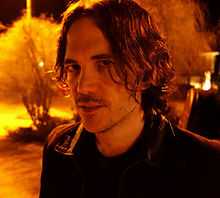Nick Palumbo
| Nick Palumbo | |
|---|---|
|
Nick Palumbo in 2014 | |
| Born |
Nick Palumbo November 12, 1970 Washington, D.C., US |
| Occupation |
Director producer screenwriter |
| Years active | 1999–present |
Nick Palumbo (born November 12, 1970) is an American feature motion picture director, writer and producer. He is the CEO of Fright Flix Productions, Inc. Palumbo is internationally known by film fans and cinema critics for making ultraviolent, visually stunning and unnerving horror feature motion pictures, which have caused ongoing public media controversy since their releases.
Early life
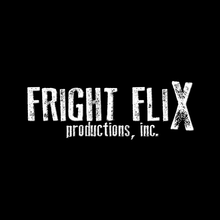
Palumbo was born in Washington, D.C. to a father who was successful commercial paint service company CEO and a mother who worked as a Naval operational intelligence officer for the United States Department of Defense at The Pentagon. Palumbo's parents divorced in 1978. Palumbo's extended family lived in the southeastern states of Virginia and Kentucky. Palumbo's paternal grandparents emigrated to the U.S. from Naples, Italy, while his maternal grandparents emigrated from Galway, Ireland, both in the 1930s.
At the age of five, Palumbo was brought along by his father on several unusual and disturbing commercial painting contract jobs. These included painting jobs at many local mortuaries, where Palumbo witnessed death first-hand in the form of human corpses in the embalming and viewing rooms. By the age of ten, Palumbo was exposed to grisly criminal aftermath when he began assisting his father by painting the walls of homicide crime scene interior locations, as per the request of local law enforcement authorities, in greater Washington, D.C., Virginia and Maryland.
Palumbo gained a strong interest in cinema as child. His father routinely took him to attend a wide variety of first-run and second-run 1970s and 1980s motion pictures at local drive-ins, cinemas and revival movie houses in metropolitan Washington, D.C.[1] There, Palumbo saw such feature films as Martin Scorsese's landmark modern noir feature, Taxi Driver, Stanley Kubrick's dark satirical masterpiece study of youth anarchy and its inevitable decline, A Clockwork Orange, as well as Tobe Hooper's seminal horror feature, The Texas Chain Saw Massacre (1974), the stars of which, Gunnar Hansen and Edwin Neal, Palumbo would later direct in his second feature film, Murder-Set-Pieces. Palumbo cites the works of notable feature motion picture directors Roman Polanski and Dario Argento as those that have directly influenced his own work as a director. Palumbo has watched literally thousands of feature motion pictures over the course of his lifetime and feels that all of them have informed some aspects of his work. Palumbo's favorite feature film is Charles Laughton's classic crime thriller, The Night of the Hunter.
In 1983, Palumbo and his father moved to Las Vegas, Nevada, where he would live and work for over twenty years. Palumbo later attended the Columbia College Hollywood Film School from 1989–1991 in Los Angeles, before returning to Las Vegas. After learning the technical aspects of filmmaking, Palumbo worked on several low-budget feature films to gain additional knowledge and experience. Dividing his time between Las Vegas and Los Angeles, Palumbo continued to work on film productions and write original screenplays.
Film career
Nutbag
In the summer of 1999, in Las Vegas, Palumbo wrote, produced and directed his first feature motion picture, Nutbag, for only $50,000.[2] Nutbag depicted the point of view of a serial murderer during a week in his life. Nutbag went into production in June of the same year under some of the most extreme weather conditions, with temperature averages over 100 °F[3] and a record-breaking deadly flood.[4]
Nutbag was initially released as a limited edition commercial VHS tape. This ultra-low budget horror debut placed Palumbo and his motion picture production company, Fright Flix Productions, at the forefront of independent horror filmmaking. Nutbag generated largely positive reviews and cover articles by such international horror media magazines as the United Kingdom's The Dark Side, Canada's Rue Morgue and Fangoria in U.S., amongst several others. Soon after, in 2001, ITN Distribution sold Nutbag at the Cannes Film Festival for the international market on DVD as a significantly edited release that same year.
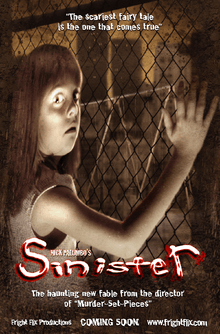
Legendary feature horror film director Herschell Gordon Lewis described Nutbag as "An angry and unsettling film. Disturbing and not easily forgotten." Lewis was a significant champion of the feature film upon its initial release.
Sinister
In 2002, Palumbo began writing the screenplay for a short film entitled Sinister, which was produced and shot on 35mm film entirely on location in New York City on a budget of $80,000 later that year.[5] Sinister depicted the story of a little girl who faces a decadent inner city life and escapes through her imagination and fairy tale stories. Sinister was presented in its entirety as an extra feature on the director's first DVD release of Murder-Set-Pieces in 2005.
Murder-Set-Pieces
By the late summer of 2003, Palumbo began work on the screenplay for his next feature film, Murder-Set-Pieces.[6] This time around, Palumbo set his sights on creating a visually stunning and truly evocative big screen filmic enterprise. In order to achieve this goal, Palumbo spent over eighteen months seeking private funds throughout Las Vegas, meeting with hundreds of potential investors until he secured nearly $2,500,000 in capital.
Palumbo next enlisted performing horror icon Gunnar Hansen, who played "Leatherface" in the original groundbreaking horror feature, The Texas Chainsaw Massacre, as well as Edwin Neal from the same film. Palumbo then hired actor Tony Todd, known for his work as the title character in Clive Barker's popular horror film franchise, Candyman, Oliver Stone's Academy Award-winning Platoon , Clint Eastwood's Bird (1988), The Crow and Final Destination. Actress Cerina Vincent, know for her roles in Eli Roth's Cabin Fever and Not Another Teen Movie also joined the cast of Murder-Set-Pieces.
Set against the backdrop of the Las Vegas underbelly, "Murder-Set-Pieces" depicts a man whose vocation is murder. Like Nutbag, this story is told via the psychopathic lead character's point of view. Palumbo is quoted as saying that he wanted to shoot a film that effectively mirrored the horrific stories typically told on the nightly news.
In the summer of 2003, Murder-Set-Pieces was shot by cinematographer Brendan Flynt on 35mm film at dozens of locations throughout Las Vegas, Nevada. Notably, Flynt previously shot the only 35mm motion picture film footage of the tragic World Trade Center terrorist attacks and horrific building collapse that took place on September 11, 2001 in New York City. Palumbo incorporated this footage into a montage for a nightmare sequence about the breakdown of society dreamt by the antagonist.[7] Murder-Set-Pieces was edited by Todd C. Ramsey, known for his award-winning work for horror film director John Carpenter, including the feature horror re-make of The Thing (1982) and Escape From New York, as well as Star Trek: The Motion Picture and other feature films.
Murder-Set-Pieces was theatrically released by Blackwatch Releasing in a number of major U.S. cities, including Los Angeles, Las Vegas, New York and Chicago on December 24 – Christmas Eve – of 2004. The original theatrical release of Murder-Set-Pieces had a running time of 105 minutes. Murder-Set-Pieces was submitted to Motion Picture Association of America's Classification and Rating Administration, which threatened the film with a dreaded NC-17 rating without the requirement of major editing. While Palumbo stated in several interviews that Murder-Set-Pieces was intended as an NC-17 film because of the strong graphic content, he and the producers ultimately chose to release the film unrated to accommodate a major city theatrical release. Over a half dozen continuous, realistic murder scenes take place in the feature film. The special effects team enlisted for Murder-Set-Pieces employed the use of over 55 gallons of special effects blood over the course of the production for the film.
After the theatrical release of Murder-Set-Pieces, several notable national film critics responded to the movie:
"For his second feature film effort, director Nick Palumbo erupts onto the cinematic scene with a high-anxiety spectacle that induces aneurysms in guardians of decency. Palumbo has made his own apoplectic fit of a movie in which blood cascades down faces and torsos, wherever fists, blades, bullets and, yes, a chainsaw blade have broken the skin. Palumbo's monstrous tableaus might just provoke cries for restrictions in art, even among staunch defenders of artistic freedom."[8]
– Ned Martel of The New York Times on January 7, 2005
"Murder-Set-Pieces is about to blow everyone's minds. It's incredibly good. It's extremely well made. It's directed impeccably, and it's definitely, no holds barred, the most brutal and graphic film I've ever seen (that includes porn and all horror films). Murder-Set-Pieces is the serial killer film to end all serial killer films."[9]
– Heidi Martinuzzi of Film Threat Magazine on January 18, 2005.
“An interesting effort to make the ultimate horror movie by imitating modern classics of the genre in a systematic way, putting actors from the original The Texas Chain Saw Massacre into the cast for good measure. Be warned that the results are in aggressively frightful taste from beginning to end, though."[10]
– David Sterritt of The Christian Science Monitor on January 7, 2005
"4 out of 4 Stars – For slasher film fans, this is the pot of gold at the end of the blood stained rainbow. The most erotically charged, aggressively deranged, unabashedly brutal American horror film EVER made. The perfect date movie-if your date happens to be Charles Manson. An instant-deeply twisted-classic."
– Todd David Schwartz of CBS NEWS Radio on December 27, 2004
"Aptly titled Murder-Set-Pieces, writer-helmer Nick Palumbo's second feature offers over-the-top horror imagery as a Las Vegas serial killer dispatches one victim after another, the pic distinguishes itself via sheer extremity of gore, sadism and tastelessness."[7]
– Dennis Harvey of Variety on December 27, 2004
Murder-Set-Pieces was secondarily released through Fright Flix Productions as a limited edition DVD of 5000 units, which was sold out in the course of 4 days in the summer of 2005.
Murder-Set-Pieces was later sold to Lionsgate Home Entertainment in the fall of 2006 and was released in January 2007 as a DVD in a significantly edited form, losing 23 minutes of original footage to secure an R rating. Many scenes were greatly reduced or eliminated in the new DVD, while the color of other scenes were desaturated or made black and white to limit the strong visceral effect of the filmic gore intended by the director. The loss or alteration of many of these scenes rendered the film into a nearly senseless version of the original. Additionally, the sound and visual output quality of the Lionsgate version of the film on DVD were greatly reduced for a quick entry to market, thus further compromising the director's intention. Ironically, Lionsgate proceeded to widely release similarly themed feature horror films, such as the Saw and Hostel film franchises during the same period.[11]
Palumbo also enlisted some of the biggest names in the pornographic film industry at the time, including adult star Crissy Moran and Destiny St. Claire[12] St. Claire was so traumatized by the rape scene that she performed in that on the set of Murder-Set-Pieces she screamed that she would rather participate in "sex with over one hundred different strange men than go through that again," which was reported to Art Ettinger in Ultra Violent magazine.[13]
International Release of Murder-Set-Pieces
Ironically, following the substantial press controversy, post-production issues and compromised initial release of Murder-Set-Pieces the film was subsequently released worldwide on DVD in 2007–2010 by The Weinstein Company, Universal Pictures, Paramount Pictures and 20th Century Fox in its original uncut theatrical format and running time.
Controversy and UK ban
The film was submitted for release in the United Kingdom to the British Board of Film Classification (BBFC) who refused to give the film an '18' certificate, therefore making the film illegal to supply within the UK. The BBFC stated they rejected the film because of sexual violence, and the film was potentially breaking UK obscenity laws.[14]
Palumbo has both incited and endured a great deal of public media controversy that has arisen since the release of Murder-Set-Pieces.
In 2007, Dee Snider, lead singer of the 1980s heavy metal band, Twisted Sister, and host of Sirius Satellite Radio's Fangoria Radio, conducted a two-part radio interview with Palumbo. Snider ingnited controversy by accusing Palumbo of being an "anti-Semite" because of Palumbo's integral use of Nazi themes and symbolism in Murder-Set-Pieces, as well as an ambiguous opening quote that skewered Jewish people at the time it was graffitied on a wall by the notorious serial killer known as Jack The Ripper near one of his murder victims. Palumbo has made references to Jack The Ripper in all of his films to date. The opening Jack The Ripper credit sequence quote is followed by a sequence of the tragic 9/11 terrorist attacks in New York City.[7] Snider misunderstood the order of this content as blaming Jewish people for the 9/11 attacks, which Palumbo flatly denied. Palumbo countered that Murder-Set-Pieces' lead character, the murderous photographer, was a descendent of Nazi criminals and thus Palumbo populated his film with directly related imagery and dialogue. Palumbo and Fangoria Radio's co-host Debbie Rochon noted that Snider, who is of Judaic descent, made a biased accusation, based on his own religious beliefs.
In November 2003, when the exposed and unprocessed film stock that comprised Murder-Set-Pieces was sent to the three largest commercial developing and printing film laboratories in the U.S. – Technicolor, Du Art[15] and Deluxe Laboratories – it was rejected by all of the companies. Each film laboratory believed that they had developed a true record of murder or at least a substantial violation of law, instead of a fictional feature film of murderous subject matter and therefore called the FBI and law enforcement, which arrested the producers of the film. Eventually, Ascent Media in Burbank, California developed and printed the film for Murder-Set-Pieces.[7]
On February 27, 2008, a new distribution company for Murder-Set-Pieces, TLA Releasing in the U.K., submitted the feature film to the British Board of Film Classification for DVD release. The BBFC effectively rejected and banned Murder-Set-Pieces. Journalist Archie Thomas describes the event of the rare U.K. ban in the February 18, 2008 issue of Variety:[16]
“The ruling comes a day after Prime Minister Gordon Brown expressed his concerns in Parliament over the potentially destructive social impact of violent films and video games. Recently, a cross-party group of politicians has been pushing for reform on violent and sexual material. If successful, the campaign could see the BBFC forced to toughen its stance.
"Rejecting a work outright is a serious matter and the board considered whether the issue could be dealt with through cuts,' commented Cooke. 'However, given the unacceptable content featured throughout, and that what remains is essentially preparatory and set-up material for the unacceptable scenes, cutting the work is not a viable option in this case and the work is therefore refused a classification."
Palumbo also came under fire from fellow filmmaker William Lustig, director of the classic horror feature film Maniac. Lustig caught an early preview of Murder-Set-Pieces in New York City. Lustig was upset by the sexualized violence depicted in Murder-Set-Pieces that he contacted Palumbo to indicate that Palumbo "went too far."
However, 1970s exploitation horror filmmkaer and Palumbo's late friend Roger Watkins, who directed Last House on Dead End Street, said that Murder-Set-Pieces is the "real deal. It is more than just a great film; it's pure poetry."[13]
Corpse and the Death of Stephan Miller
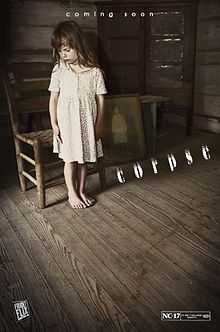
In the early spring of 2007, Palumbo and budding media mogul Stephan Miller became producing partners for Palumbo's next cinematic feature motion picture endeavor, Corpse.
Corpse was envisioned by Palumbo as an apocalyptic zombie movie-to-end-all-zombie-movies. While the feature film screenplay for Corpse ultimately made discoveries into several weighty human psychological issues, such as those generated by child abuse, it was effectively intended as wide release feature horror film for mass audiences.
During the course of the writing the Corpse screenplay, when Palumbo and Miller raised the film's $5M budget, Miller was tragically killed by a captive trained bear. On April 23, 2008, Miller was working on a regional televised commercial production with "Rocky," (who worked in countless feature films, such as Semi-Pro, starring Will Farrell) a trained Grizzly bear that Miller had worked with for years previously with his cousin Randy, a professional animal trainer and handler. In a brief moment during the shooting of the commercial, Miller was killed with one swift bite of Miller's neck. Miller died of hemorrhaging and blood loss on the spot within minutes of the attack. Palumbo took time away from work on Corpse to endure the loss of his friend. As of March 2010, Palumbo has suspended the production of Corpse, but plans to direct the film at some point in the future.[17]
The Last Gas Station
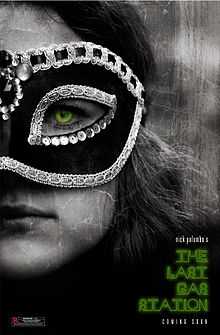
In April 2010, Palumbo teamed up award-winning actor Shawn Andrews, best known for the cult film Dazed and Confused and with acclaimed French cinematographer, Laurent Barés, to create the 35mm neo noir thriller feature motion picture, The Last Gas Station.[18]
The Last Gas Station is described by the filmmaker as "a nightmarish, hallucinogenic examination of one man's insatiable greed and the destructive path that follows in his wake."[19]
French cinematographer Laurent Barés is best known for his exquisite and moody work in the recent 20th Century Fox blockbuster action thriller, Hitman. Previously, Barés acted as director of photography on the popular horror features, Frontière(s) for Lionsgate Films and À l'intérieur for Canal Plus and The Weinstein Company. Barés also lensed over 500 major commercial advertisement campaigns for dozens of international corporations.
The Last Gas Station is currently in the last stages of pre-production, as the film has gone through a myriad of cast and crew. Palumbo is still moving forward with the project with actor Shawn Andrews. Production is set to begin in late 2015.
Muse
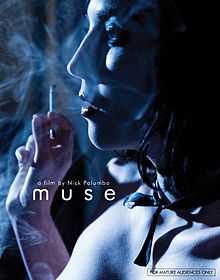
Palumbo's pycho-sexual horror film "Muse" will be released in 2015.[20]
References
- ↑ "Dvdresurrections.com". Dvdresurrections.com. Retrieved 2014-08-15.
- ↑ Nutbag at the Internet Movie Database
- ↑
- ↑ Timothy Lomprey (July 8, 2009). "A decade after deadly flood, county better prepared – Las Vegas Sun News". Lasvegassun.com. Retrieved 2014-08-15.
- ↑ Sinister at the Internet Movie Database
- ↑ Murder-Set-Pieces at the Internet Movie Database
- ↑ 7.0 7.1 7.2 7.3 Dennis Harvey (December 27, 2004). "Murder-Set-Pieces". Variety. Retrieved 2014-08-15.
- ↑ http://movies.nytimes.com/2005/01/07/movies/07murd.html
- ↑ "Murder-set-pieces". Film Threat. January 18, 2005. Retrieved 2014-08-15.
- ↑ "Movie Guide - CSMonitor.com". Webcache.googleusercontent.com. January 7, 2005. Retrieved 2014-08-15.
- ↑ "Nick Palumbo interview". Iconsoffright.com. Retrieved 2014-08-15.
- ↑ "Welcome To Club Destiny St Claire!Welcome To Destiny St Claire!". Clubdestinystclaire.com. Retrieved 2014-08-15.
- ↑ 13.0 13.1 "ULTRA VIOLENT MAGAZINE – Ultra Violent Issue 7". Uvmagazine.com. Retrieved 2014-08-15.
- ↑ "MURDER SET PIECES | British Board of Film Classification". Bbfc.co.uk. February 27, 2008. Retrieved 2014-08-15.
- ↑ "DuArt". DuArt. Retrieved 2014-08-15.
- ↑ "U.K. censor bans serial killer film". Variety. February 28, 2008. Retrieved 2014-08-15.
- ↑ "Bear Owner Stunned By Death of His Cousin". CBS News. April 24, 2008. Retrieved 2014-08-15.
- ↑ The Last Gas Station at the Internet Movie Database
- ↑
- ↑ Muse at the Internet Movie Database
External links
- Nick Palumbo at the Internet Movie Database
- Nutbag at the Internet Movie Database
- Sinister at the Internet Movie Database
- Murder-Set-Pieces at the Internet Movie Database
- The Last Gas Station at the Internet Movie Database
- Muse at the Internet Movie Database
- Nick Palumbo official website
- Nick Palumbo on Twitter
- https://www.facebook.com/musefilm
- Fright Flix Productions, Inc official website
- The Last Gas Station website
|
